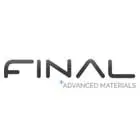Ceramic substrate
Overview: Ceramic Substrates
Final Advanced Materials supplies a wide variety of substrates: alumina, zirconia, and aluminium nitride. All our substrates are produced by laser cutting. It is possible to order plates in standard dimensions, or for parts to be cut to a customized design, whether for a prototype or for series production.
Final Advanced Materials has machining facilities which guarantee ISO 9001-certified quality. Our tooling and our expertise permit the production of the most complex components from your plans.
Facilities
- Laser machines with appropriate cutting heads for different materials.
- Automated laser machines with video-based dimensional control systems.
- Programming facility for all commonly employed data formats (dxf, dgw, iges, cadl, stl, etc.)
Available materials
- 99 % porous alumina Al2O3
- 96 and 99.6 % high-density alumina Al2O3
- Zirconia ZrO2
- Aluminium nitride AlN
Applications of Ceramic Substrates
- Sintering equipment
- Oven construction elements
- Medical technology
- Electronic sensors
- Catalyser
- Filtration of liquids
Benefits of Ceramic Substrates
- Hardness
- High mechanical strength
- Dimensional stability, even at high temperatures
- High resistance to wear and corrosion
- Electrically insulating
- Resistance to chemical products
- High-temperature withstand
- Dielectric and ferro-electric properties
- Very low adherence
- Exceptional flatness
- Low thermal conduction
Comparative Table
|
Property |
Ceramic |
Metal |
Polymer |
|
Hardness |
High |
Low |
Bad |
|
Elastic Modulus |
High |
Good |
Low |
|
Resistance to High Temperature |
High |
Low |
Bad |
|
Thermal Expansion |
Low |
Good |
Good |
|
Malleability |
Low |
Good |
Good |
|
Corrosion Resistance |
Good |
Low |
Low |
|
Erosion Resistance |
Good |
Low |
Low |
|
Electrical Conductivity |
Low |
Good |
Low |
|
Density |
Average |
High |
Low |
|
Thermal Conductivity |
Average |
Good |
Low |
Our range of Ceramic Substrates
Alumina
Alumina substrates are highly rated for their good chemical and mechanical resistance. They can be employed for the construction of furnaces, in medical technologies, in electronic sensors, in catalysers, in SOFC fuel cells and for the filtration of liquids.
Two types of alumina substrates are available:
Sintered High-Density Alumina
This substrate is available in the form of two products, the alumina content of which varies between 96 and 99.6 %. Whichever the product, these materials are distinguished by their high resistance to corrosion and abrasion. Moreover, they show good mechanical strength, and can be employed as electrical insulators. They show very low adherence and, by nature, feature exceptional flatness. Finally, alumina substrates show good thermal conduction. High-density alumina substrates are available in various thicknesses (0.15 – 0.25 – 0.38 – 0.5 – 0.76 – 1 – 1.27 – 1.52 – 2 mm) and in dimensions ranging from 50.8 x 50.8 mm to 168 x 168 mm.
Sintered Porous Alumina
A porous alumina substrate has mechanical, electrical and chemical properties which are similar to those of high density alumina. However, this product is distinguished by its lightness. Its porosity makes it a material of choice for the filtration of gases and liquids, and for the homogeneous diffusion of a fluid. Porous alumina substrates are available in various thicknesses (1 – 1.5 - 2 mm) and in dimensions ranging from 100 x 100 mm to 168 x 168 mm.
Aluminium Nitride
An aluminium nitride substrate is a semiconductor with a wide band gap (6.2 eV). This refractory and electrically insulating material has a very high thermal conductivity and shows good resistance to oxidation and abrasion.
Aluminium nitride substrates are available in various thicknesses (from 0.5 to 1.5 mm) and in dimensions of up to 138 x 190.5 mm.
Zirconium
ZYTC substrates are thin, rigid, tape cast structures composed of zirconia stabilized with yttria at targeted stabilization concentrations. ZYTC is our thinnest zirconia material and is ideally suited as a setter for sintering microelectronics, solid oxide fuel cells and thermal management applications under conditions of high temperatures and in varied atmospheres. ZYTC has been high fired and is tightly bonded resulting in a dust free, smooth gas tight surface. ZYTC is dimensionally stable to 1,500 °C. It has exceptional resistance to oxidizing and reducing atmospheres at high temperatures. Zirconia does, however, lose a small amount of oxygen at very high temperatures in vacuum and inert or reducing atmospheres. Although this reaction results in a colour change from white to grey, other properties remain essentially unchanged.
Technical Data of Ceramic Substrates
A comparative table for the available ceramic substrates can be downloaded in the data sheet.
Physical variables included in this documentation are provided by way of indication only and do not, under any circumstances, constitute a contractual undertaking. Please contact our technical service if you require any additional information.

Alumina Ceramic Substrate

Aluminium nitride Ceramic Substrate


